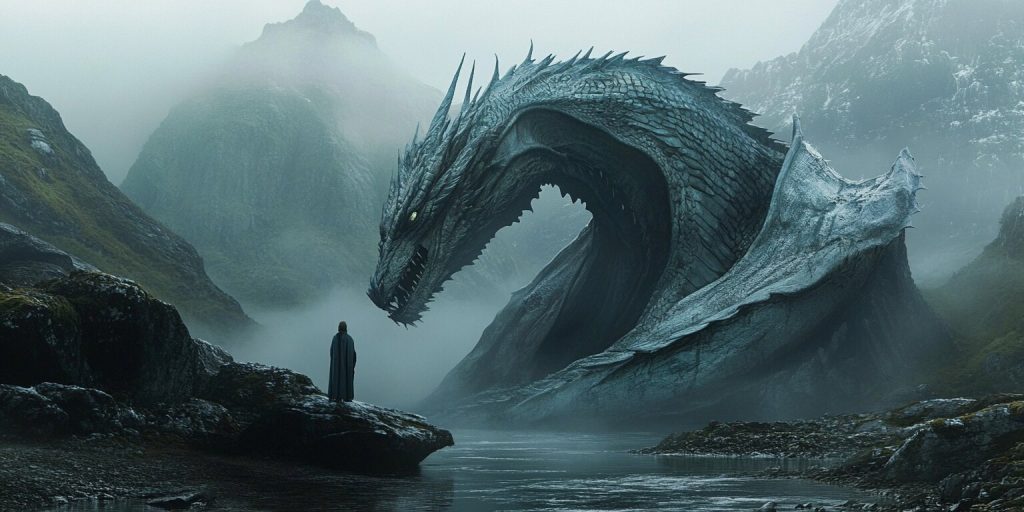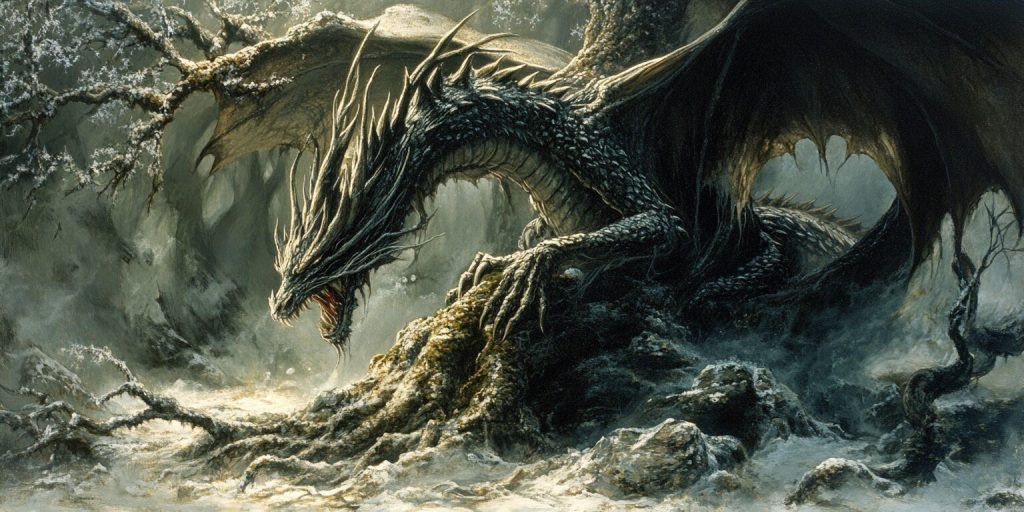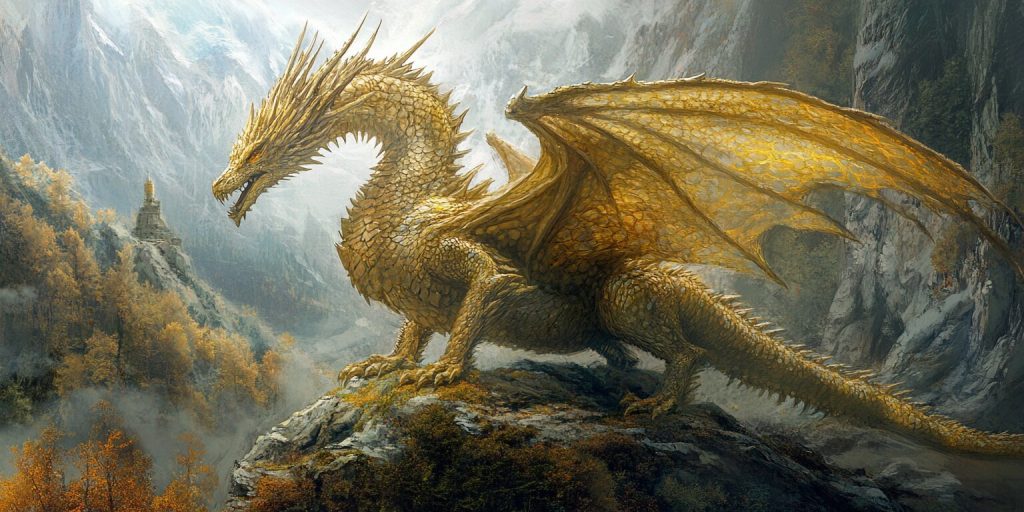Creatures in Norse mythology, Jörmungandr (Midgard Serpent or World Serpent), Nidhogg, Norse Mythology
Exploring the Dreki: Norse Mythology’s Legendary Dragon
The dreki is a fascinating figure in Norse mythology. It shows the power and fury of dragons in Viking stories. This creature is known from the Old Norse name for “dragon.” It is a key part of the stories from ancient Scandinavia.
This article will examine the dreki’s historical importance and show how the dragon’s legacy, particularly that of Fafnir, has captured people’s imaginations for many years. We’ll use sources like the Poetic Edda and archaeological discoveries to learn more.
This will help us understand its role in Viking society and show the importance of dragons in Norse mythology.
The Origins of Dreki in Norse Mythology
The dreki, a fascinating dragon from Norse mythology, has roots in early Germanic and Proto-Germanic traditions. Old texts and stories show these dragons as more than just animals. They carry deep symbolic meanings in Norse beliefs.
These dragons symbolize power, chaos, and the balance between creation and destruction. The Poetic Edda and other stories keep their tales alive. They show how these dragons are part of Norse culture and spirituality.
They are seen as powerful beings that challenge heroes, often embodying traits of the god of war. They also represent the wild, untamed parts of nature.
- Dreki appears as the guardian of the treasure
- Connections to creation myths through serpent forms
- Reflections on the transformative power of dragons in tales
Learning about the dreki’s origins deepens our understanding of Norse mythology. It shows the richness of these ancient stories. It also highlights how they mix danger and beauty in one being, often illustrated with dragon heads.
Characteristics of the Dreki and Other Dragons
The dreki is a key figure in Norse mythology. It is huge and strong, with the power to breathe fire. These traits are also found in other Norse dragons like Fáfnir and Níðhöggr. They add to the rich stories of dragons.
The dreki has long bodies and big wings. These wings let it fly through the air. It also has claws, scales, and sometimes more heads. These features make it look very scary.
- Grand size and powerful stature
- Potential for fire-breathing abilities
- Elongated bodies and wings
- Distinctive scales and claws
Norse dragons play many roles in myths. Some guard treasures, while others, like the Germanic dragon, bring chaos. This shows how complex their relationships are with heroes. These heroes often show bravery and cleverness in their battles with dragons.
These dragon traits make the stories of Norse mythology exciting. They create a world full of different tales and legendary fights.
Dreki Norse Mythology: Significance in Viking Culture

The dreki is a big deal in Viking culture. It stands for power and the wild side of nature. Vikings looked up to these dragons as symbols of big challenges. They saw them as tests for heroes to show they were strong.
The dreki’s importance is seen in many parts of Viking life. This includes war, art, and stories. It shows how much these dragons meant to the Vikings.
The Symbolism of Dragons in Norse Lore
Dragons in Norse stories mean more than just being fierce. They show the two sides of nature: protecting and destroying. They are seen as fierce protectors of treasures but also as threats to people.
This shows how Vikings saw nature. They were both scared of it and respectful of it. Stories like Fáfnir show dragons as both dangers and legacies.
Comparative Analysis with Other Mythical Creatures
Looking at the dreki and other mythical creatures shows they share traits like power and guardianship. Even though different cultures see them differently, they often symbolize ambition and danger. For example, unlike the fierce ones in Norse stories, Eastern dragons are seen as kind and bring rain.
Yet both kinds of dragons, including those associated with Odin, play big roles in their mythologies. This shows how important dragons are in stories around the world.
Famous Dreki Tales and Legends
Norse mythology, including the sagas of Odin and Loki, is full of famous tales of courage and conflict. The stories of Fáfnir and Sigurd are especially famous. They show how heroism and greed can mix in interesting ways.
These stories look into human nature and show the battle between heroes and monsters.
Fáfnir and the Treasure Hoard
Fáfnir was once a dwarf but became a powerful dragon because of his love for gold. He made a treasure hoard that many heroes, including those in sagas, tried to find. This treasure shows how greed can lead to bad things.
Sigurd and the Slaying of Fáfnir
Sigurd is known as a brave hero who fought Fáfnir. His battle with the dragon was a big test of his courage. This story is a classic tale of defeating a dragon in Viking stories.
It shows how brave Sigurd is and warns us about the dangers of being greedy. It also celebrates the bravery and determination of heroes.
Connections between Dreki and Other Norse Creatures
Norse mythology is full of stories about dragons and other magical beings. The dreki is known for its strength and has deep ties with other creatures. These bonds show the complex world of Norse myths.
They often tell stories of battles and balance. This adds depth to the myths.
Relationship with Jörmungandr: The Midgard Serpent
Jörmungandr, the Midgard Serpent, is a powerful being in Norse stories. It fights against chaos in the world. Its battle with Thor during Ragnarök shows how dragons and giants challenge gods and heroes.
This shows the dreki’s role as a big test for gods and heroes. It shows the bravery and strength needed to overcome these challenges.
Dreki and Níðhöggr: The Gnawer at the Roots
Níðhöggr is another dragon in Norse myths, eating at Yggdrasil’s roots. This shows a cycle of life and death, highlighting themes of rebirth. The dreki and Níðhöggr show how creation and destruction are linked in myths.

They help tell the story of Norse mythology’s complex world, including the tales of nidhogg’s and other legendary creatures.
Dreki Representations in Art and Literature
The dreki is a big part of art and literature, especially in Eddic texts and Viking Age art. These dragons are more than just stories; they stand for big ideas in Norse culture. Art and literature show how dragons are linked to Viking beliefs and values.
Depictions in Eddic and Poetic Texts
Eddic texts, like the Poetic Edda, tell stories with dragons in many roles. These stories show dragons as scary beasts and symbols of greed and power. Skaldic poetry also brings dreki to life with its detailed words and pictures, letting readers dive into Norse mythology.
Symbolic Illustrations in Viking Age Art
Viking Age art shows off symbolic pictures of dreki. In some tales, you can see dragons on longships, helmets, and weapons, also known as the Midgard serpent. The Hylestad stave church portal is a great example, with its beautiful dragons. These pictures show how much Vikings respected these mythical creatures, often depicting them in their sagas.
Modern Interpretations of the Dreki Legend
The dreki’s story lives on in today’s movies, books, and games. Filmmakers, authors, and game makers draw from its legend. They bring the dreki into our stories, linking old tales with new ones.
Dreki in Contemporary Media
In today’s media, the dreki shows up in movies, TV shows, and games. These stories keep the dragon’s fascination alive. They mix old Norse myths with new stories, making them exciting for us.
- Films feature dragon-like beings inspired by the dreki’s grandeur and the legends of Icelandic dragons.
- TV shows use Norse legends, sometimes adding dreki-inspired characters or plots.
- Video games let players experience the dreki legend, making it interactive.
Influence on Fantasy Literature and Popular Culture
The dreki has a big impact on fantasy books. Many authors use the word dreki and its stories and traits in their work. This brings myth and imagination together. Dragon themes also touch fans in popular culture.
- Books tell stories that capture the dreki’s spirit, drawing in fans of fantasy and adventure.
- Dragon-themed merchandise shows how much people love these creatures, bringing them into our lives.
- Dragon-themed events bring fans together, creating a sense of community.
The dreki is a strong symbol in today’s stories. It touches fantasy books and popular culture, leaving a mark.
Conclusion
The dreki is a key figure in Norse mythology. It shows the deep stories of dragons and their place in Viking culture. These dragons, such as Fafnir and Nidhogg, tell us about power, danger, and bravery.
People still love the dreki and what it stands for, even today. Modern stories keep the dreki’s legend alive. They show how the dreki’s stories connect us to Viking times.
The dreki is a favorite in stories that make us think and explore. By looking at its many stories, we see how dragons affect our view of history and ourselves. The dreki’s tales add to Norse myths and remind us of stories’ power in shaping who we are.

